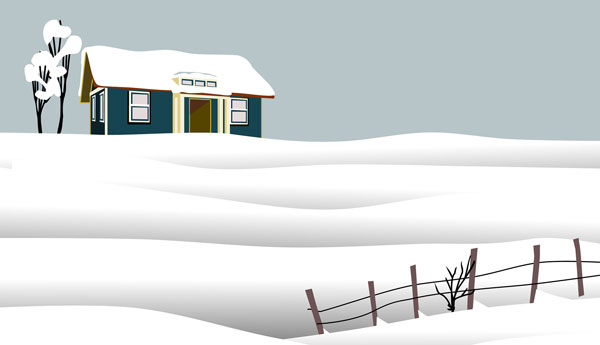
Water access is one of the most overstated, yet still somehow underrated components to a successful homestead. Everyone knows its important, but its almost impossible to fully fathom just how much it is. From watering plants, to animals, to keeping your own self healthy, water is truly the basis for life. In the winter, however, water access (and specifically retention) can get tricky. So how do you collect it? Read on for more.
Collection
In the warmer months, collecting water is easy. Perennial creeks flow and thunderstorms send rain down in torrents. In the wintertime, though? Rain turns to snow, which is far less dense in H2O. As it happens, you can still harvest the bounty of the sky, your system will simply need a few tweaks.
For starters, your rain barrels are likely set up to collect water running off your roof, pooling in your downspouts. If not, they should be, as the surface-area of your roof increases your yield exponentially (think how much more water hits the surface of your roof than the small opening of a barrel). Do note, however, that typical asphalt shingles are NOT suitable for catching rainwater, as there are far too many toxic chemicals that can leach out. If you’re using your roof as a catchment system, it should be made of pre-painted metal. All that said, the primary issue in the wintertime becomes getting that snow to melt off your roof, and into the downspouts.
The most effective way to do this is to install heating coils. The downside, of course, is not everyone has the coin to do so, or the time to undertake such a project. Luckily, there are alternatives. The easiest way to mimic the effect of a heating coil is to heat the attic. Much like defrosting a windshield, this will eventually begin to warm the bottom layers of snow, promoting snowmelt. Depending on your method of heating, however, it could also run up the power bill, and not every house has a true attic. The next option is to brush off excess snow. If you’re somewhere very snowy, having too much snow can actually be counterproductive as it inhibits melt. Lessening the volume of snow will increase the effect of sun on the top, and your home’s heat on the bottom, speeding up the melting process.
Filtration
Another downside to collecting water in the wintertime, is that the extra time snow spends on your roof can expose it to contaminants in a way that doesn’t happen when water is freely flowing. As a result, you’ll need to make sure your filtration system is really up to snuff. A quantum filtration system represents the top-of-the-line offering for this particular market. While the intricacies of the science behind it are a little complex for this homesteader, it essentially uses a positively charged surface to attract the electrons in the pathogens, which are then decimated when they contact an active silica ceramic surface. These systems use no power, and are relatively easy to install.
Another option is UV filtration. While it needs to be used in conjunction with a particulate filter, as it will not clean debris, a UV filter essentially uses a medical-grade backlight to blast pathogens to smithereens. If you’ve seen the LARQ water bottles that are all the rage lately, it works off the same principle.
Finally, there are good ol’ gravity filters, that work like the Brita in your fridge. Pour it in the top, and water coming out the bottom will be 99% bacteria and particulate free.
So this weekend, wherever you are, hope for a white Christmas! Not only will the kids love it, but it may just help you fill your water barrels after all.
A humble homesteader based in an undisclosed location, Lars Drecker splits his time between tending his little slice of self-sustaining heaven, and bothering his neighbors to do his work for him. This is mainly the fault of a debilitating predilection for fishing, hunting, camping and all other things outdoors. When not engaged in any of the above activities, you can normally find him broken down on the side of the road, in some piece of junk he just “fixed-up.”
